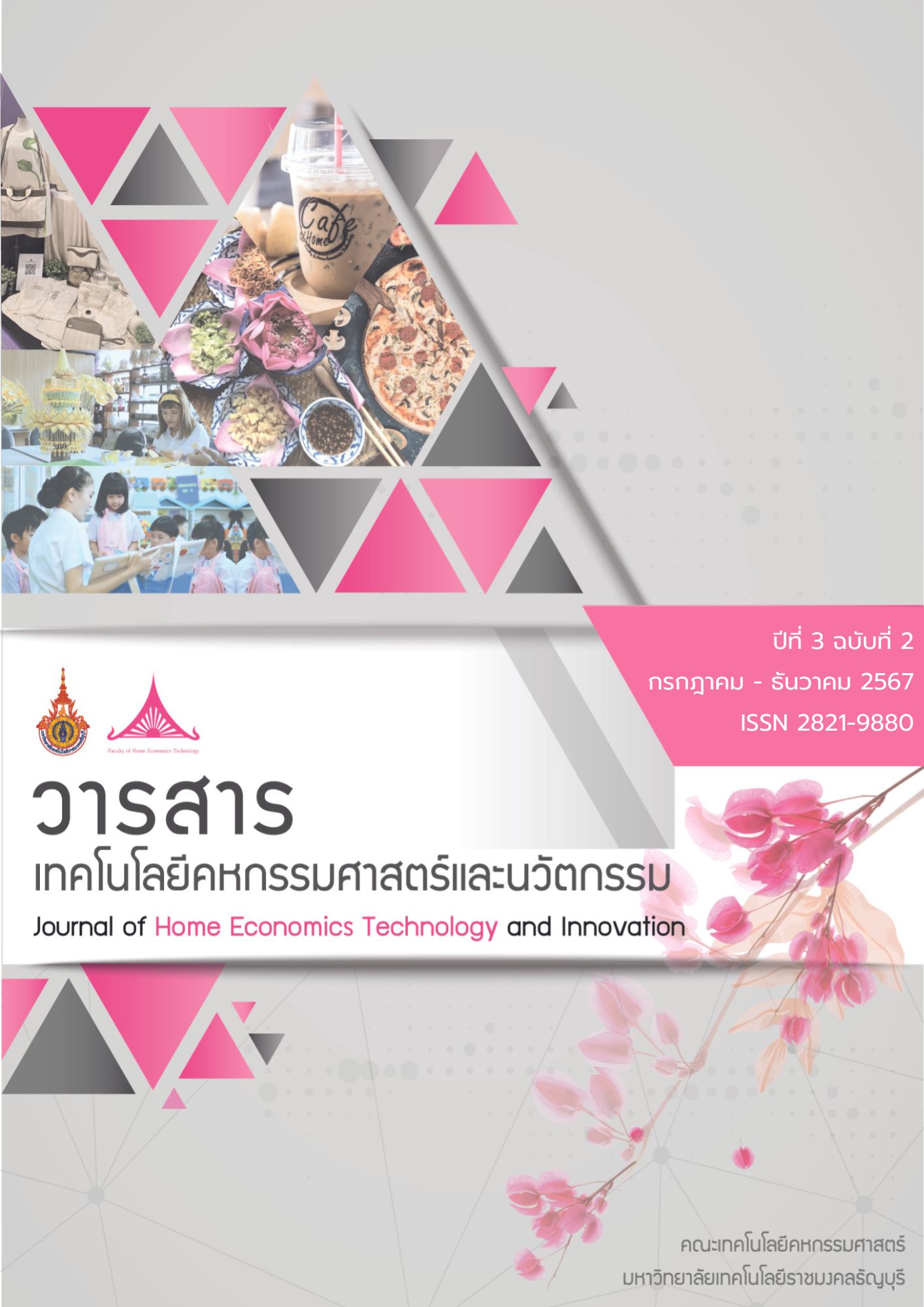Effects of Bleaching Agent Treatment on Pumpkin Vines for Wickerwork Products
Main Article Content
Abstract
This research aimed to study suitable types of pumpkin vines and treatment processes, as well as to examine the chemical and physical properties of pumpkin vine fibers for wickerwork applications. The study investigated two types of pumpkin vines: fresh and dried. The bleaching treatment duration was varied at three levels: 0, 4, and 8 hours, using a 1:1 ratio of bleaching agent to water. A completely randomized factorial design was employed, resulting in 6 experimental treatments. Results showed that dried pumpkin vines treated with bleaching agent for 4 hours exhibited optimal characteristics, with a moisture content of 28.93 ± 1.10%, tensile strength of 74.87 ± 1.67 N, brightness value (L*) of 79.45 ± 0.04, color value (a*) of 1.35 ± 0.03, and color value (b*) of 1.34 ± 0.03. These characteristics were suitable for subsequent glycerin treatment. The glycerin treatment phase examined soaking durations at three levels: 1, 2, and 3 days. The findings indicated that specimens treated with glycerin for 3 days demonstrated optimal characteristics for wickerwork product formation, with a tensile strength of 95.85 ± 0.34 N.
Article Details
Articles published are copyright of the Journal of Home Economics Technology and Innovation. Rajamangala University of Technology Thanyaburi The statements contained in each article in this academic journal are the personal opinions of each author and are not related to Rajamangala University of Technology Thanyaburi and other faculty members at the university in any way Responsibility for all elements of each article belongs to each author. If there is any mistake Each author is solely responsible for his or her own articles.
References
โครงการหลวง. (2533). คู่มือส่งเสริมการปลูกพืชผักบนที่สูงในประเทศไทย. เชียงใหม่: ดารารัตน์การพิมพ์.
จินตนา กิจเจริญวงศ์ และยุพเรศ เอื้อตรงจิตต์. (2558). การประเมินการได้รับสัมผัสของซัลเฟอร์ไดออกไซด์จากการบริโภคผักและ
ผลไม้แห้งนำเข้าจากต่างประเทศของคนไทย พ.ศ. 2548-2557. วารสารกรมวิทยาศาสตร์การแพทย์, 57(1), 58-68.
โชติอนันต์ อินทุใสตระกูล. (2551). สมุนไพรไทย สำหรับงานสาธารณสุขมูลฐาน. 160 หน้า.
พจน์ธรรม ณรงค์วิทย์ และ ราชัน แพ่งประเสริฐ. (2560, 15 - 16 มิถุนายน). เชือกกล้วยฟั่น จากหัตถกรรม สู่การพัฒนาผลิตภัณฑ์ใน การประชุมวิชาการระดับชาติ “โฮมภูมิ ครั้งที่ 3 : Wisdom to the Future : ภูมิปัญญาสู่อนาคต”. (น.437-445). คณะสถาปัตยกรรมศาสตร์ มหาวิทยาลัยขอนแก่น.
พิมพ์เพ็ญ พรเฉลิมพงศ์ และนิธิยา รัตนาปนนท์. (2548). วัตถุเจือปนในอาหาร. สืบค้นเมื่อ 17 ธันวาคม 2565, จาก https://www.foodnetworksolution.com/wiki/word/1955/sulfites-ซัลไฟต์?fbclid=IwAR1RyhzHOLo2-IMhPxjw9nntPONPEE_D0AIxbBnHqNg3Mu9p6RGULe6B5BU.
วาสนา สายมา. (2564). การศึกษาและพัฒนารูปแบบงานจักสานไม้ไผ่ลวดลายดั้งเดิม เพื่อประยุกต์ใช้ในการออกแบบตกแต่งกรณีศึกษา ชมรมผู้สูงอายุ บ้านกิ่วแลป่าเป้า อ.แม่วาง จ.เชียงใหม่. วารสารวิจัยและพัฒนา มหาวิทยาลัยราชภัฏสวนสุนันทา, 13(2), 119–133. https://doi.org/10.53848/irdssru.v13i2.251021.
สุวัฒน์ สิงห์เทพ, สุภา จุฬคุปต์ และ สุทัศนีย์ บุญโญภาส. (2558). การพัฒนาเชือกผักบุ้งสำหรับผลิตภัณฑ์งานประดิษฐ์. ใน การประชุมวิชาการและนำเสนอผลงานวิจัยระดับชาติ ครั้งที่ 35. (น.2071-2079). บัณฑิตวิทยาลัย มหาวิทยาลัยราชภัฏราชนครินทร์.
อุษณีย์ภรณ์ สร้อยเพ็ชร์, ปิยมาสฐ์ ตัณฑ์เจริญรัตน์ และสุธาทิพย์ ไชยวงศ์. (2564). ผลของฟักทองบดแห้งต่อประสิทธิภาพการผลิตไข่ไก่และสีของไข่แดงในสูตรอาหาร ไก่ไข่ปลดระวาง. วารสารแก่นเกษตร, ฉบับพิเศษ(1), 64 - 67.
Kapook. (2564, 5 พฤษภาคม). ฟักทอง เทคนิคปลูกฟักทองง่าย ๆ ได้ผลผลิตดีงาม. สืบค้นเมื่อ 19 เมษายน 2566, จาก https://home.kapook.com/view238302.html.
Murkovic, M., U. Mulleder, and Neunteufl, H. (2002). Carotenoid content in different varieties of pumpkins. Journal of Food Composition Analysis, 15: 633–638.
WordPress. (2559, 6 ตุลาคม). ภูมิปัญญาไทย…การจักสาน. สืบค้นเมื่อ 24 มีนาคม 2566, จาก https://project43687.wordpress.com/ความเป็นมาของเครื่องจั/


